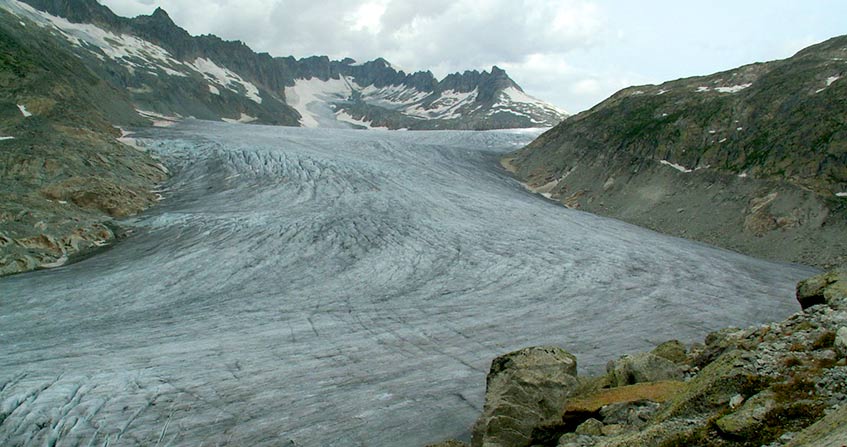海上塑料污染:“第七大洲”
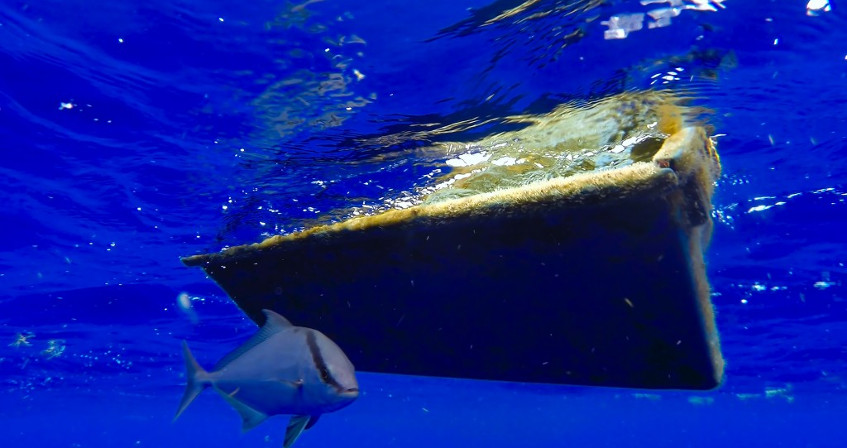
世界上最大的垃圾场离我们很远,距离法国领土有几千公里。因为这些被污染区域的地区面积如同一个大陆,所以我们称它为第七大洲。据估计,每分钟有80至120吨垃圾最终汇入海洋;其中很大一部分是塑料垃圾。密度较大的垃圾碎片会沉积至海底,而密度较小的漂浮碎片则随洋流流动,最终汇聚及累积在几个亚热带环流区中。这种塑料污染对环境和人类有什么影响呢?
1. 塑料污染从何而来?
自20世纪50年代商业化应用以来,塑料(工业)取得了巨大的成功。它的全球产量呈指数式增长。在2012年达到了2.88亿吨,比1975年增长620%。塑料的成功来源于其卓越的品质:易于成型、成本低、耐腐蚀、耐磨损……塑料是理想的包装材料。包装是塑料主要应用领域 (据Plastics Europe [1]报道,塑料在包装领域的应用占总应用的40%到50%)。
据估计,80%的海洋垃圾来自陆地。这种污染主要来自家庭垃圾。这些垃圾未能妥善地收集和循环利用,或者是它们被丢在野外或路边。风将这些垃圾刮走,雨水将它们冲刷进下水道、河流和小溪,最终这些垃圾汇入海洋。造成这种污染的主要原因是人们对这些垃圾的放任自流。除此之外,洪水和海啸等自然灾害的贡献也不可忽视。
据估计,2010年有500万至1300万吨的海洋塑料污染是由家庭或城市垃圾管理不当造成的[2]。更令人担忧的是,到2025年,这一数字可能会增加10倍,或者说每年有500万至1300万吨塑料汇入海洋。这一增长主要是由新兴国家的塑料消费量的增加引起的,而这些国家尚未建立起完善的垃圾收集和循环利用基础设施。
2. 塑料是如何在大洋环流中积累的?
很具有典型性的海水表层塑料污染已经引起了科学界和公众的极大关注。但事实上,没有一个生态系统能够幸免,即使是最偏远的地区也受到了影响:海湾、河口、湖泊、沙漠和深海平原也受到了塑料的污染。由于河流是塑料汇入海洋的主要载体,针对河流污染必须进行更深入的研究。
虽然海上塑料污染的最初迹象可以追溯到20世纪70年代,但直到20世纪90年代,才有这一领域的美国专家同时也是航海家的C·摩尔[3]首次就某些地区塑料的积累问题向科学界发出警报。塑料碎片降解非常缓慢,它们在海洋环境中能够长期存在。大洋环流连接五大海洋盆地,同时在其影响下,海洋碎片聚集在“亚热带环流”中。这些大的反气旋涡旋运动(即与地球自转方向相反的运动) 伴随着在海洋表面的缓慢汇聚流动,使漂浮的颗粒聚集在一起。
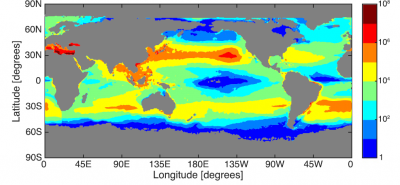
[数据来源:E. van Sebille的文章,2015年Environmental Research Letters]
译者注:Longitude 经度 Latitude 纬度 Degrees 度
全球的海洋中共有5个塑料聚集区,分别是北太平洋、南太平洋、北大西洋、南大西洋和印度洋。这5个聚集区在图1的地图上以橙色或红色显示。此外,地中海和黑海也是塑料碎片的高浓度聚集地。
我们通常谈论到的塑料大陆并不是我们可以行走的陆地。塑料污染堆积的面积和大陆一样大,由此得名“第七大洲”。最大的塑料污染区域位于北太平洋,其面积接近法国的6倍,即340万平方公里。
3. 海洋中塑料的状况如何?
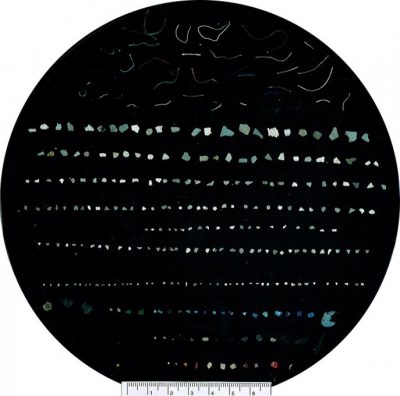
[图片:www.Septiemecontinent.com]
每种塑料都有多种用途,因此必须防腐耐用。一旦进入环境,塑料的这种特性就成为它的一个主要缺点。根据其种类与性质,塑料的寿命可以从几年到几个世纪不等。在海上,在波浪磨耗和太阳辐射的作用下,塑料分解。因此如图2所示,在亚热带环流中,大多数塑料碎片只有一两毫米大小。
第七大洲含有相当多的细小的塑料碎片,这些塑料碎片颗粒称为微塑料。亚热带环流表层水体中微塑料的平均密度为每平方公里200,000至600,000个颗粒。这种塑料污染延伸覆盖数百万平方公里,因此可以估计,有万亿量级的塑料微粒漂浮在我们的海洋中[4]。
4. 对环境有什么影响?
4.1. 困住的动物,吞下的塑料
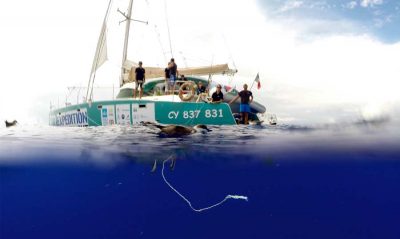
[©Vinci Sato-www.Septiemecontinent.com]
塑料污染的第一个也是最直接的影响是将动物困在流网或大块碎片中。这是海洋哺乳动物、海龟和鸟类死亡的一个主要原因。
第二个直接影响是摄入。这关系到海洋生态系统的整个食物链,这一观点现在已被普遍接受。塑料碎片的尺寸具有连续性,从几厘米到一微米(千分之一毫米)甚至一纳米(百万分之一毫米)不等。
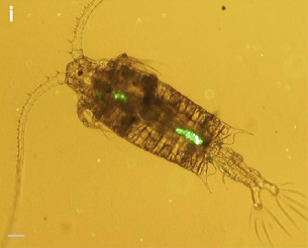
[图片来源:来自文章“Microplastic ingestion by zooplankton”,《Environmental Sciences and Technology》,2013年,第47卷,第6646-6655页]
食物链中每一种大小的海洋生物都能对应一种大小的、可能被其摄入的碎屑。摄入后,塑料在动物的消化系统中积累,从而导致动物进食减少,最终死亡。在图4中,我们可以看到积累在桡足类动物(浮游动物)消化系统中的微米级聚苯乙烯碎片[5]。
4.2. 外来入侵物种
许多生物附着在塑料上,其中一些可能是入侵性的生物,在数十年的时间里能随着洋流迁移几千公里。这是对生态系统平衡的一个真正威胁。
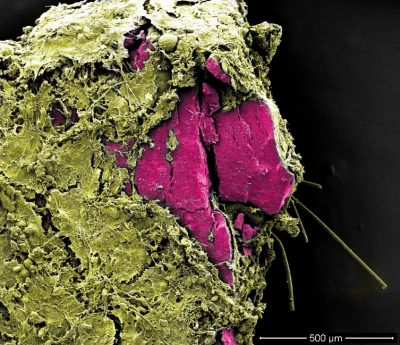
与塑料相关的生物多种多样,包括鱼类、藻类、贝类等。它们中有些肉眼可见,有些则是尺寸微小。此外,研究表明在环流中的塑料上生长的细菌不同于海洋环境中的天然细菌。其中一些细菌可能具有潜在的致病性。这些与塑料相关的生物体被称为塑料生物圈(plastisphere)(图5)。
4.3. 已证实的化学污染
这些塑料碎片代表化学污染,原因有几个。一个是塑料含有一些化合物,这些化合物在摄入后通过化学方式转移到海洋生物体内(这些化合物被称为是生物可利用的)。其中一些化合物具有潜在的毒性,可以在生物体内积累(它们被称为是生物可积累的)。此外,塑料在环境里老化的过程中,在制造时加入到塑料中的化合物(主要是添加剂)可能会释放到环境中,或者当塑料被生物体摄入后,这些化合物也可能经生物体排放到环境中。
塑料也是持久性有机污染物(POPs)的载体。由于塑料在河流、小溪和海洋中会长时间停留,有些塑料能够富集环境中的污染物。因此,塑料可以将这些POPs分子的浓度从初始值增加到10万倍。这些分子也可以在不同生物体中进行生物富集,即沿着食物链越来越浓缩。2013年发表在《自然》(Nature)杂志上的一篇文章中,几名研究人员共同提议将塑料碎片归类为有害物质[6]。但目前还没有进一步的行动。
塑料对生态系统的污染问题非常复杂,科学家目前还无法全面评估其对生态系统平衡和消费者健康的影响。塑料污染的社会和经济影响也是必然和重大的。需要政府当局作出承诺,改进城市废物的管理。对每个人来说,有关塑料污染意识和责任担当也很重要。
参考资料及说明
[1] PlasticsEurope: http://www.plasticseurope.fr/
[2] Jambeck, J. R.; Geyer, R.; Wilcox, C.; Siegler, T. R.; Perryman, M.; Andrady, A.; Narayan, R.; Law, K. L. (2015) “Plastic waste inputs from land into the ocean”, Science 347, (6223), 768-771.
[3] Moore, C. J. (2008) “Synthetic polymers in the marine environment: A rapidly increasing, long-term threat”. Environmental Research 108, (2), 131-139.
[4] Eriksen, M.; Lebreton, L. C. M.; Carson, H. S.; Thiel, M.; Moore, C. J.; Borerro, J. C.; Galgani, F.; Ryan, P. G.; Reisser, J., (2014) “Plastic Pollution in the World’s Oceans: More than 5 Trillion Plastic Pieces Weighing over 250,000 Tons Afloat at Sea”. Plos One 9 (12).
[5] Cole, M.; Lindeque, P.; Fileman, E.; Halsband, C.; Goodhead, R.; Moger, J.; Galloway, T. S., (2013) “Microplastic Ingestion by Zooplankton”. Environmental Science & Technology 47, (12), 6646-6655.
[6] Rochman, C. M.; Browne, M. A.; Halpern, B. S.; Hentschel, B. T.; Hoh, E.; Karapanagioti, H. K.; Rios-Mendoza, L. M.; Takada, H.; Teh, S.; Thompson, R. C., (2013) “Classify plastic waste as hazardous”. Nature 494, (7436), 169-171.
环境百科全书由环境和能源百科全书协会出版 (www.a3e.fr),该协会与格勒诺布尔阿尔卑斯大学和格勒诺布尔INP有合同关系,并由法国科学院赞助。
引用这篇文章: TER HALLE Alexandra, PEREZ Emile (2024年3月9日), 海上塑料污染:“第七大洲”, 环境百科全书,咨询于 2024年4月25日 [在线ISSN 2555-0950]网址: https://www.encyclopedie-environnement.org/zh/eau-zh/plastic-pollution-at-sea-seventh-continent/.
环境百科全书中的文章是根据知识共享BY-NC-SA许可条款提供的,该许可授权复制的条件是:引用来源,不作商业使用,共享相同的初始条件,并且在每次重复使用或分发时复制知识共享BY-NC-SA许可声明。







